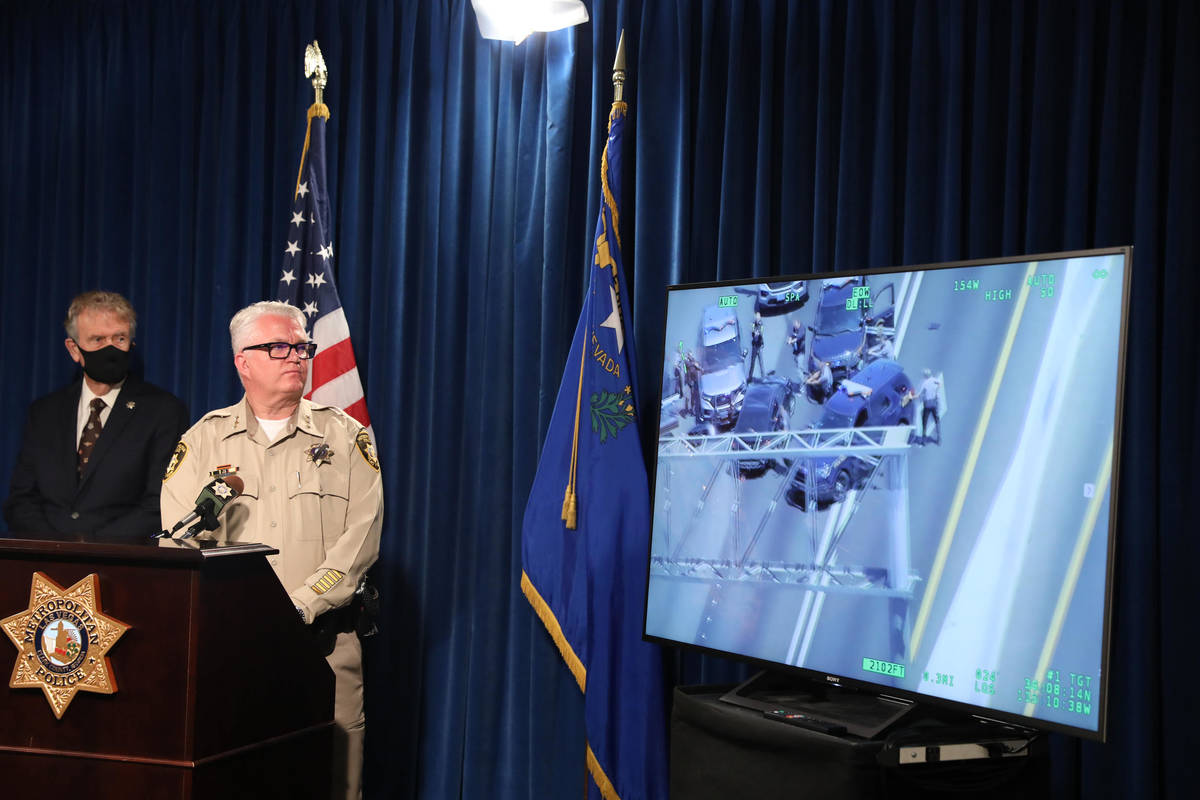‘Stop sticks,’ like those used by Nevada trooper, pose great risk
The Nevada trooper struck during a vehicle pursuit on Interstate 15 last month was attempting to puncture the tires of a stolen car using a police procedure that has left dozens of officers dead nationwide over the past two decades.
Trooper Micah May, 46, was deploying “stop sticks” when he was struck by the stolen car near Charleston Boulevard on July 27, the Nevada Highway Patrol has said. He was airlifted to University Medical Center, where the married father of two and 13-year Highway Patrol veteran died two days later.
The sticks, known to police as tire deflation devices, or TDDs, involve an officer throwing a spiked mat into the path of a vehicle to deflate its tires. The endeavor has proved deadly for police in both rural counties and crowded cities across the United States time and again, experts say. The nonprofit National Police Foundation said in an email to the Las Vegas Review-Journal that there have been 22 “law enforcement officers killed while deploying stop sticks” from 2009 to 2021. The figure is based on information compiled on the Officer Down Memorial Page.
The next morning, the number rose to 23 when Brooklyn, Illinois, police officer Brian Pierce Jr., 24, was killed while deploying stop sticks on a bridge in an attempt to stop a car during a police pursuit.
Hamilton Township, Ohio, police Chief Scott Hughes told the Review-Journal he’s “not a proponent of” TDDs.
“There is no safe place for you to stand to effectively deploy these,” he said.
Hughes said the carnage caused by using TDDs is extensive. He started tracking the deadly encounters after two fatalities in the region of Ohio where he works, with close encounters he personally had while using TDDs. Hughes’ statistics indicate 37 officers have died deploying TDDs since 2001.
The police chief said there is no data tracking how often officers are injured using TDDs but survive. He has written about the hazards of TDDs for one of the nation’s largest law enforcement training companies, Calibre Press, including an article titled “How Many Flat Tires Are Worth an Officer’s Life?”
Hughes quoted a saying from law enforcement risk-management expert Gordon Graham that states, “If it is predictable, it is preventable.”
“If it is predictable that placing a police officer out on the side of the road with a car coming at you at 100 mph, that could lose control and hit you … then it is preventable,” Hughes said. “So why are we putting our people out there?”
Judgment call
May was one of several officers involved in the pursuit of Douglas Claiborne, 60, who stole a car and drove erratically down the interstate before striking May. During a briefing on Aug. 2, Metropolitan Police Department Undersheriff Christopher Darcy said troopers tried to deploy the stop sticks six times “yet Claiborne was able to maneuver around them.” May was struck while attempting to use them a seventh time.
Darcy said during the briefing that using stop sticks can involve making judgment calls during a pursuit. Darcy noted he was not speaking on behalf of the Nevada Department of Public Safety, which oversees the Highway Patrol.
“Sometimes it is hard to predict, but we try to identify those areas where it would be safe to use them and deflate the tires to try and slow the pursuit down and bring it to a safe conclusion,” Darcy said of TDDs. “That’s what the officers were doing and the troopers were doing when they were out there.”
The Highway Patrol had another tragedy involving TDDs two decades ago. Trooper Robert “Bobby” Kintzel was critically injured but survived when he was run over while placing metal spikes on U.S. Highway 95 near Flamingo Road in April 2001. The motorist who hit him, Vornelius Phillips, was being sought in a slaying and two carjackings. Authorities said at the time that Phillips was driving 95 mph when he struck Kintzel. Phillips is serving a life sentence in Nevada.
Highway Patrol policy on police pursuits states the decision on whether to initiate a pursuit involves weighing the “degree of risk that pursuits inherently cause due to their unpredictability.” The document also lists factors to consider in allowing pursuits to continue, with many of those factors focusing on safety of the public and of officers, weather, vehicle speeds and whether the offender’s identity is known.
The document details the Highway Patrol’s intervention techniques to stop pursuits. One of the techniques available is TDDs, referred to by the Highway Patrol as “road spikes.”
“Use of any intervention tactic is not a reason to continue to pursue when deemed unsafe,” the document says. “A pursuit can be discontinued or re-evaluated at any time during the pursuit even after an intervention tactic has been used.”
The document states intervention tactics, including TDDs, should only be considered “if the timing and the situation permits” and if an officer is trained in the technique. Use of an intervention technique such as TDDs requires approval of a supervisor when available.
“Spike strips should be deployed only when it is reasonably apparent that only the pursued vehicle will be affected by their use,” the document states. “Officers should carefully consider the limitations of such devices as well as the potential risk to officers, the public and occupants of the pursued vehicle.”
Hughes said there is a debate in law enforcement about whether to continue to use TDDs, and the debate varies by department. The Dallas Police Department, for example, has banned their use.
Hughes believes the devices should never be used on interstates because of the speed of vehicles, traffic and a lack of cover. But it is also known that TDDs are effective tools to stop police chases “when everything goes right,” Hughes said.
“When it is done right and nobody gets hurt … it’s great,” he said. “It’s when they don’t work and when things don’t go right that unfortunate, tragic situations like just what occurred in Las Vegas happen.”
Contact Glenn Puit by email at gpuit@reviewjournal.com. Follow @GlennatRJ on Twitter.
































